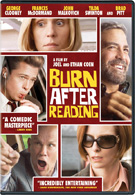For people who finally got into the Coen Brothers after their Academy recognized No Country for Old Men, their latest film, Burn After Reading probably seems like a disappointment. For those who have been following the siblings since earlier pictures like Fargo, The Hudsucker Proxy, and The Man Who Wasn’t There, their latest film is more of what we’ve come to expect from the Coens: a rather eccentric storyline driven by quirky characters played by some of Hollywood’s best performers. It’s no No Country, but what it is, is quite humorous. By the Coen’s own admission, categorizing or summarizing Burn After Reading is next to impossible. It was sold as a spy-comedy, but it really has nothing to do with that. Sure, it involves a few CIA (or ex-CIA) agents, but it really isn’t a spy movie. The best way to describe the story is what happens when people in mundane lifestyles start believing themselves to be involved in something more exciting, and then let both their imaginations and their actions get away from themselves.
Following a ridiculously large cast of characters around Washington DC, the plot centers around Osborne Cox (John Malkovich), a CIA analyst who leaves the service after being mistreated and decides to write his memoirs. At the same time, his wife (Tilda Swinton), in the process of beginning a divorce against Osborne, copies files from the analyst’s computer and promptly loses the disc. The lost data winds up in the hands of two gym employees (Brad Pitt and Frances McDormand) who start out trying to do the right thing by returning the disc to its rightful owner, and then get greedy, selfish, and caught up in what they believe to be serious spy shit. Then things really get nuts.
Burn After Reading is one giant comedy of errors. Almost all of the really good comedic moments come from one character or another making a really bad (and typically stupid) decision. Handled poorly it’s the kind of comedy that winds up being a big disaster. Here it’s assembled well enough to make the audience want to keep watching, if only to see what stupid thing is going to happen next. It’s also the kind of movie that doesn’t have a huge payoff though. The movie keeps you wondering what could possibly solve everything that’s going on until the very end, where the resolution is not only satisfactory, but ultimately the only choice the writers could make on how to end the story. To say it’s a complete solution would be lying though. There’s definitely a bit of a cop-out factor involved, but worth watching at least once. The problem is, once you know how the movie plays out, watching it again might be less satisfactory.
Ultimately what makes Burn After Reading worth watching are the characters, and mainly because they are in the hands of such capable actors. It’s fun to watch John Malkovich go a little crazy, while Brad Pitt, Frances McDormand, and George Clooney aren’t afraid to make total idiots of themselves to help drive the story forward. Honestly, this is probably the most fun I’ve had watching Clooney on screen outside of the Ocean’s movies; Clooney isn’t usually an actor I find myself interested in watching, but his characterization here is strongly compelling, if only to find out the mystery of what his adulterous character is building in his basement.
The Coens definitely take a step back from what they accomplished with No Country For Old Men with this movie, and Burn After Reading is nowhere near the pinnacle of their accomplishments in quirky comedy. It’s no Hudsucker Proxy or Big Lebowski. It is, however, a much more satisfying ride than The Ladykillers or Intolerable Cruelty. If you like what the writer/director siblings have done before, you’ll probably enjoy Burn. If you haven’t experienced it before, this isn’t a bad place to start visiting that side of their career. I’ve been reading many critics, including Roger Ebert, talk about how suggesting a movie is worth a rental is really poor advice. Either a movie is worth seeing, or it isn’t, which is why I didn’t put the suggestion to rent Burn After Reading in the above section, which is focused on the movie. Burn After Reading is worth seeing, in my mind. With less than twenty minutes of special features however, it is not worth buying on DVD. This isn’t a critical statement about the movie. It’s just a comment driven from basic consumerism.
There are only three extras on the DVD for Burn After Reading, and none of them are much good. Key things like the theatrical trailer or a commentary track are absent. The Coens have never been much on commentary tracks for their movies, so this isn’t surprising. Considering the size of the cast though, it’s amazing there’s no commentary at all. Heck, I’d love to see Malkovich play his analyst character and handle an in-character commentary track, written by the Coens. Wouldn’t that be interesting?
Unfortunately all we get here are three featurettes. “Finding the Burn” is a very short making-of featurette that really doesn’t talk much about making the movie. It just explains what the movie is about (or, particularly, how the movie is difficult to describe) and shows a little behind the scenes footage. “DC Insiders Run Amuck” is the longest of the featurettes and looks at the various characters in the movie. It’s interesting to hear the actors talk about their involvement, particularly Clooney and Malkovich, and costume designer Mary Zophres weighs in with the choices made for each character’s wardrobe. Finally, “Welcome Back George” is a less than two-minute look at Clooney’s three picture relationship with the Coens, and his acknowledgement that he has played a moron in each film for them.
Your Daily Blend of Entertainment News
While Burn After Reading is definitely a movie worth watching once, the lack of a decent replay value and the sparse extras found on the DVD go a long way against recommending this as a purchase. While the movie is worthwhile, this is a disc for renting, not adding as a permanent title to your library.

